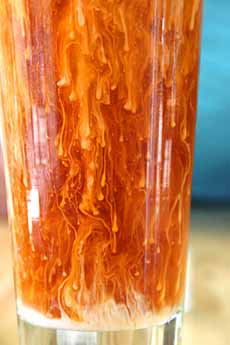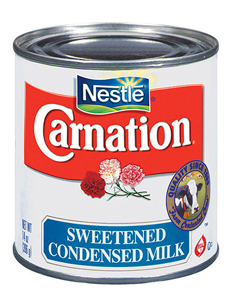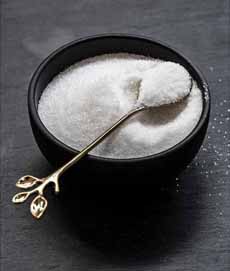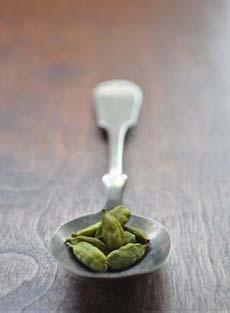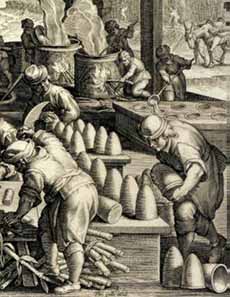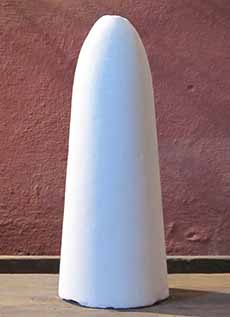Thai Iced Tea Recipe With Sweetened Condensed Milk
|
WHAT IS THAI ICED TEA? Thai iced tea, known as cha-yen (cha is the word for tea), is served in Thailand, Vietnam, elsewhere around the Pacific Rim and in Thai restaurants in the West and elsewhere around the world. It’s made from strong-brewed black tea and sweetened condensed milk, which adds body and creamy mouthfeel. The brewed tea can be enhanced with spices, such as cardamom, clove, nutmeg, star anise, and tamarind. If you like chai tea with milk and sweetener, you’ll equally like Thai iced tea. For visual appeal, the deep amber tea and white condensed milk are swirled together or layered. The drink can be topped off with evaporated milk, coconut milk, half and half, or whole milk. The countries where it’s most popular are known for hot, steamy summers. Thai iced tea is a welcome refreshment—and a complement to spicy food. If your neck of the woods is as hot and steamy as ours is, it’s time to try the recipe. > The history of sugar is below. Ingredients For 6 Servings 1. STEEP the tea leaves (and any optional spices) in boiling water for 5 minutes. Strain out the tea leaves. Using an infuser (tea ball) makes this step easier. 2. STIR in the sugar until dissolved while the tea is still hot; then stir in condensed milk. 3. COOL to room temperature or ideally, chill in the fridge. 4. ADD ice to tall iced tea glasses and pour in tea mixture until glasses are roughly 3/4 full. Slowly top off glasses with evaporated milk. If you find yourself in the Pacific Rim, you can have what Americans think of as iced tea. Sugar is native to Southeast Asia, with three species seeming to have originated in two locations: Saccharum barberi in India and Saccharum edule and Saccharum officinarum in New Guinea, part of modern Indonesia. Some scientists believe that cane sugar actually originated in New Guinea and spread to India. Indian sailors carried sugar along various trade routes. In 326 B.C.E., Alexander the Great and his troops saw farmers on the Indian subcontinent growing sugar cane and making the crystals, which were called sharkara, pronounced as saccharum. The Macedonian soldiers carried “honey-bearing reeds” home with them. But sugar cane remained a little-known crop to most Europeans for the next thousand years, a rare and costly product that made sugar traders wealthy. Originally, people chewed on the raw sugar cane stalks to enjoy the sweetness from the sap. Refined sugar appears around 500 B.C.E. when residents of what is now India began to make sugar syrup from cane juice. They cooled it to make crystals that were easier to store and transport. These crystals were called khanda, which is the source of the word candy. In 510 B.C.E. Emperor Darius of Persia invaded India, and was delighted to find “the reed which gives honey without bees.” Returning to Persia with the bee-less reed, the secret of cane sugar was kept a closely guarded secret. When Arabs invaded Persia in 642 C.E., they discovered sugar cane and learned how it was grown and produced. As the Arab conquerors expanded their empire, sugar plantations appeared in North Africa, Spain, and elsewhere. Sugar was only discovered by western Europeans as a result of the Crusades in the 11th century C.E. The first notice of sugar was recorded in England in 1069 [source]. Although sugar arrived in Europe around 1100, it was very expensive and not widely used except by the wealthy, who used it both to sweeten foods and as a medicine. Venice began to produce sugar in Lebanon to supply Europe, where honey had been the only available sweetener. By the 15th century, Venice was the chief sugar refining and distribution center in Europe. It should be noted that sugar did not arrive granulated, in a box. It was originally sold in cones because the refining process involved pouring the boiled sugar syrup into inverted conical molds. This allowed the molasses—the by-product of sugar refining—to drain out through a small hole at the bottom of the mold. The result: a solid cone of white sugar, called a loaf (hence the term sugarloaf). the cone shape facilitated the purification and drying of the sugar crystals, and the loaf that could be easily stored. It was portioned by shaving at the pointed end. In the 16th century, the price of sugar, though still high, was affordable by the middle class. By the mid-16th century, recipes for baked goods and confectionery showed sugar being used freely. And, many experts today would say, it is now used far too freely. Perhaps use was slower then, due to the challenge of shaving rock-hard sugar from the cone. There had to be a better way, and in 1843 by Jakub Krystof Rad who was a director of a sugar refinery in Dačice, Bohemia, Austria-Hungary, developed it. As the story goes, his wife sliced her finger cutting a lump of sugar and complained that sugar should be made in a convenient size for a cup of tea. He went to work inventing the process and machinery to cutting large blocks of sugar into small, uniform pieces: the sugar cube. Great, but there was still a better way. Refining techniques improved due to the development of new technologies and large-scale sugar production in the Americas, and granulated sugar finally became widely available in the late 19th century. Check out the different types of sugar in our Sugar Glossary. |
|
|
|
CHECK OUT WHAT’S HAPPENING ON OUR HOME PAGE, THENIBBLE.COM. |
||

